#carlo basso
Explore tagged Tumblr posts
Text
Speculating on Banco de Crédito
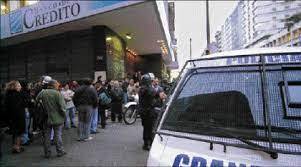
The so-called “archives of terror” discovered by a human rights lawyer in Paraguay over a decade ago continue to yield new information on the cooperation between the de facto regimes that ruled much of South America in the 1970s and 1980s. These documents confirmed that Moon-owned banks in Uruguay were used as a part of Operation Condor, though it remains unclear to the public to what extent.
I have heard before that in the 80s, Paul Schafer’s Colonia Dignidad community in Chile, which became close allies of Pinochet and for many years hosted the military and its torture chambers for political prisoners, had money in several banks, including in Argentina and Uruguay. Were they by chance using Moon’s Banco de Crédito in Uruguay?
(Researcher and author Carlo Basso had mentioned before that Colonia Dignidad even had offices in San Francisco in the U.S. - there’s a lot more to be said about Colonia Dignidad and its pedophile leader - you can watch the 5-episode docuseries The Survivors, Colonia Dignidad on Amazon Prime) Related links and notes below
On Moon’s Political Network and their Deep Connections to Global Terrorism 4,200 female Japanese followers allegedly deposited as much as $25,000 each in the Moon-controlled Banco de Credito. Consortium News: Rev. Moon’s Bank Scam Uruguay’s freewheeling banking system that operated as a laundromat for drug money. Moon bought a bank. Chicago Tribune: Unification Church Invests Heavily Uruguay (December 1994) On Banco de Crédito
Banco de Credito out of Moonie hands
Notes on Moonie Drug Trade
The Irish Times: Moonies accused of involvement in drugs (2004)
Moon’s activities in South America
FFWPU President of IAPP (The International Association of Parliamentarians for Peace) Prosecuted for Money Laundering and Drug Smuggling in US Court; suspicions of connections to UC / FFWPU Leadership from Robert Parry -
Another close church associate, who also requested anonymity out of fear of reprisals, said cash arriving from Japan was used in one major construction project to pay “illegal” laborers from Asia and South America. “They [the church leaders] were always waiting for our money to come in from Japan,” this source said. “When the economy in Japan crashed, a lot of our money came from South America, mainly Brazil.” …”
#operation condor#colonia dignidad#carlo basso#san francisco#Banco de Crédito#Banco de Credito#moonies#unification church#banks#unification church in south america#south america#uruguay#paraguay#terrorism#pinochet#william branham#paul schafer#dina#dictatorship#government
0 notes
Text
Le ventisette sveglie di Atena Ferrari di Alice Basso: un viaggio tra fragilità e forza interiore. Recensione di Alessandria today
Alice Basso presenta una nuova protagonista che ci invita a riscoprire noi stessi
Alice Basso presenta una nuova protagonista che ci invita a riscoprire noi stessi Alice Basso, autrice amata per la sua capacità di creare personaggi indimenticabili, torna con un nuovo romanzo, Le ventisette sveglie di Atena Ferraris. Con una scrittura fresca e incisiva, Basso ci accompagna in un viaggio emozionante tra enigmi, relazioni familiari e la scoperta di sé. Biografia…
#Alessandria today#Alice Basso#Alice Basso libri#Alice Basso narrativa#Atena Ferraris#Forza Interiore#gemelli#Google News#introspezione e crescita#introspezione psicologica#ironia e profondità#italianewsmedia.com#Le ventisette sveglie di Atena Ferraris#Letture consigliate#Libri bestseller#libri contemporanei#libri di mistero#libri emozionanti#mistero#mistero e magia#narrativa brillante#narrativa di qualità#narrativa femminile contemporanea#narrativa italiana#narrativa moderna#personaggi complessi#Pier Carlo Lava#protagoniste femminili#protagonisti unici#relazioni e crescita
0 notes
Photo




Alanis (2017) Anahí Berneri
June 5th 2023
#alanis#2017#anahi berneri#sofia gala castiglione#dana basso#silvina sabater#carlos vuletich#dante della paolera
0 notes
Text
Moon Girl and Miracleman come to Marvel Unlimited's Who Is…? series
Moon Girl and Miracleman come to Marvel Unlimited's Who Is…? series #comics #comicbooks #marvel #digitalcomics #marvelunlimited
WHO IS…? MOON GIRL INFINITY COMIC #1 Writer: Mohale MashigoArtist: Jethro MoralesColorist: Carlos LopezEditor: Lauren AmaroOne-shot launches on Wednesday, February 8 Young genius and Inhuman Lunella Lafayette displays bravery beyond her years, using her vast intelligence and her telepathic link with Devil Dinosaur to become a hero. Read her complete super-powered origin now! WHO IS…?…

View On WordPress
#carlos lopez#digital comics#edgar delgado#jethro morales#lauren amaro#leonard kirk#mark basso#marvel#marvel unlimited#miracleman#mohale mashigo#moon girl#ram v.#who is miracleman#who is moon girl
0 notes
Text
Carlo Tessarini (ca.1690-1766?) - Concerto for Violin, Strings and Basso continuo in a-minor, Op. 1 No. 7, III. Allegro. Performed by Marco Pedrona, violin & direction, and Ensemble Guidantus.
#carlo tessarini#baroque#classical music#violin#orchestra#baroque music#rarely performed composers#violin concerto#concerto#strings#string orchestra#violinist
40 notes
·
View notes
Text

Storia Di Musica #354 - Astor Piazzolla, Libertango, 1974
Nello stesso anno in cui in Brasile Jorge Ben iniziava la sua rivoluzione della musica del suo paese, nei territori dei cugini argentini si consumava il più famoso degli assassini musicali (premetto subito in senso simbolico). Fu però un delitto che non portò alla fine, ma alla rinascita e alla rivoluzione di uno mondo magico ma dalle regole ferree, fiero del suo conservatorismo: il tango. Oltre che musica e il più sensuale dei balli, il tango è poesia e cultura. Nessuno sa perchè si chiami tango (dal latino tangere, io tocco) solo che nacque agli inizi del ‘900 nella zona di Rio de la Plata, diffondendosi inizialmente in Uruguay e Argentina. Nella prima metà del secolo, dal punto di vista musicale, il tango si sviluppò come musica da orchestra e canto, con figure leggendarie, come quelle di Carlos Gardel, eroe nazionale argentino (anche se i maligni sostengono che fosse uruguaiano), Roberto Goyeneche o Carlos José Pérez. Il la musica e il canto, malinconico, emotivo, teatrale modellò il genere. Uno che però non amava tanto le fissità musicali fu Astor Pantaleon Piazzolla. Figlio di genitori italiani, Piazzolla visse i primi 16 anni a New York. Studia musica e direzione d’orchestra. Si trasferisce nella seconda metà degli anni 40 in Argentina, dove diviene un virtuoso del bandoneon, lo strumento inventato da Heinrich Band nell’800 e divenuto il principe delle orchestre di tango, che per caso arriva in Argentina al seguito dei marinai tedeschi, che lo tenevano sulle loro navi ad allietare i durissimi e lunghissimi viaggi transoceanici.
Piazzolla era affascinato dall'idea di fondere elementi della musica jazz alle strutture del tango. Fu un parto difficilissimo: ritornò a fine anni '50 a New York prontissimo a diventare musicista di colonne sonore, ma in quel momento la musica era in fermento per la rivoluzione del jazz che Kind Of Blue di Miles Davis e poi il nucleo del free jazz di Ornette Coleman stavano portando. Finì senza un soldo e solo per la generosità di un editore musicale che gli pagò un anticipo su una delle sue canzoni più famose (e che ritroveremo tra poco) ritornò in Argentina. Qui però un infarto lo segna profondamente, tanto che tramite alcuni amici si trasferisce in Italia. Ed è proprio qui, nella culla della sua famiglia, che inizia la rivoluzione: registrò nel 1974 l’album che lo fece conoscere al mondo interno.
Libertango, dall’unione tra libertad (in questo caso espressiva) e tango. Registrato a Milano con una favolosa sezione d’archi diretta da Umberto Benedetti Michelangeli, ma soprattutto con l’innesto di una sezione ritmica di chiara matrice jazz composta dal basso elettrico di Pino Presti e dalla batteria di Tullio de Piscopo, il disco ridisegna il tango, che attraverso le dissonanze del jazz, l’innesto di strumenti elettrici e una nuova idea compositiva diviene Tango Nuevo. I puristi ovviamente gridano allo scandalo, e definiscono Piazzolla el asesino del tango. Persino Borges se ne risentì, e si dice che lo chiamasse Astor Pianola. Fu persino accusato di non essere mai stato argentino, un camorreno, per le sue origine italiane. Ma poco possono le critiche contro la sensualità e dal forza di Libertango, meravigliosa, famosa per l’innumerevole quantità di usi cinematografici e pubblicitari (per esempio, nella pubblicità della Vecchia Romagna, prima del penoso remix di David Guetta). Vi aiuto a capire le differenze: confrontate la sua musica con quella che accompagna una delle scene più famose del cinema degli ultimi 30 anni: quando Al Pacino in Profumo Di Donna balla il tango, si muove sul ritmo di Por Una Cabeza, uno dei classici di Carlos Gardel: il titolo, Per Una Testa in senso letterale, è l'equivalente del nostro Per Un'Incollatura, ed è una brano che gioca sulla metafora della passione del protagonista per le corse dei cavalli comparata per la sua passione per le donne. Piazzolla sciorina partendo da Libertango la sua idea nuova in altri 6 momenti: Meditango, Undertango, Violentango (clamorosa), Novitango e la conclusiva Tristango. A legare il tutto una toccante e magnifica elegia al padre, Adios Nonino, dedicata al padre morto improvvisamente (Nonino era chiamato il Padre, Don Vicente Piazzolla, e in Argentina l’immigrazione italiana ha di fatto sostituito l’abuelo\a spagnolo con nonino\a dall’italiano nonno\a riferito in senso reverenziale alle persone anziane); scritta nel 1959, è la canzone la cui vendita dei diritti gli permise di ritornare in Argentina da New York, viene ripresa e ridisegnata secondo il conjunto electrico del Tango Nuevo, con una forza espressiva ed emozionale senza pari.
Il disco, un successo per la piccola etichetta Carosello che lo sopportò, proietta Piazzolla ai vertici della musica internazionale. Di lì a poco collaborerà con grandi del jazz, dirigerà intere orchestre e spedisce il tango in una dimensione nuova ed internazionale, e che rivitalizzerà il genere, fino alle ultime evoluzioni, tipo i Gothan Project, paladini del tango elettronico. Piazzolla dimostra come è possibile difronte ad un bivio, scegliere una strada pericolosa, rischiosa, ma che può portare a risultati grandiosi. Nel rispetto di se stessi, anche della tradizione, ma che non si ferma davanti alla difficoltà. Che sia di augurio per chiunque legga queste righe.
26 notes
·
View notes
Text

Monica Belluci
Monica Anna Maria Bellucci was born on September 30, 1964 in the Italian village of Città di Castello, Umbria, the only child of Brunella Briganti and Pasquale Bellucci.
Monica grew up in a family of a farmer (father) and artist (mother). Her father likes to speak about his daughter and recollect in his mind her early years. He tells that Monica was so beautiful that the chef of the restaurant, where they had dinner, once refused to take money from them.
Teachers admired the young beauty and one of them had even drawn her portrait.
Monica started her career at the age of 13 as a model posing for the local photo enthusiast.
Later she moved to Milan fashion center where she signed a contract with Elite Model Management. Apart from Milan fashion she also posed for Dolce and Gabbana and French Elle.
Monica Bellucci is a secret dream for many men all over the world and of course, she had numerous love affairs. But the star was officially married just twice.
Her first husband was Claudio Carlos Basso. He was a fashion photographer and they got acquainted, when Claudio made photos of the godlike woman. They dated for a year and then got married on the 3rd January, 1990. Four months later they filed for divorce and finished that short unimportant marriage.
Monica Bellucci got married in 1999 for the second time. Her marriage with an actor Vincent Cassel served as a sample to many other celebrities for many years.
Vincent Cassel (3 November 1966) is a French actor. He became well known in France via his role as Vinz, a troubled French Jewish youth, in Matthieu Kassovitz’s 1995 film La Haine (Hate), which gave him two César Award nominations.
The couple got acquainted at a film set as French actor Vincent Cassel and Italian actress Monica Bellucci appeared in several films together. They wedded on the 3rd of August, 1999 and then gave a birth to two great talented daughters, Deva (born on the 12th of September, 2004) and Léonie, born on the (21st of May, 2010)
Vincent and Monica lived apart even when they were married. Monica tells, they tried to avoid marriage routine and that’s why lived in separate apartments. But it didn’t work and one of the most beautiful couples in the world got divorced in August, 2013.
Monica Bellucci was an extremely beautiful girl from the very childhood. If you think now, that the beauty of this elegant woman is a result of plastic surgery, you should just look at some of her childish photos. The star had full lips, big eyes and tender figure.
MONICA BELLUCCI MARITAL STATUS:
Divorced
MONICA BELLUCCI HUSBAND:
Claudio Carlos Basso (1990-1994)
MONICA BELLUCCI HUSBAND:
Vincent Cassel (1999-2013)
16 notes
·
View notes
Text
Nel nome dei Padri

Il Presidente De Nicola firma la Costituzione. Alla sinistra dell'immagine: De Gasperi, alla destra: Terracini.
Qui sotto l'elenco dei membri della Commissione per la Costituzione (o Commissione dei 75).
Gruppo democristiano (26 membri)
Gaspare Ambrosini
Giuseppe Maria Bettiol (sostituisce dal 10 aprile 1947 Giacinto Froggio, dimissionario, che il 6 febbraio 1947 aveva sostituito Ezio Vanoni, divenuto ministro)
Pietro Bulloni
Giuseppe Cappi
Giuseppe Caronia (sostituisce dal 22 febbraio 1947 Giuseppe Togni, divenuto sottosegretario di stato)
Giuseppe Codacci Pisanelli
Camillo Corsanego
Luigi De Michele
Francesco Dominedò
Giuseppe Dossetti
Maria Federici
Giacinto Froggio (sostituisce dal 2 luglio 1947 Umberto Tupini, divenuto ministro)
Giuseppe Fuschini
Angela Gotelli (sostituisce dal 6 febbraio 1947 Carmelo Caristia, dimissionario)
Giorgio La Pira
Giovanni Leone
Salvatore Mannironi
Giuseppe Micheli (sostituisce dal 22 febbraio 1947 Umberto Merlin, divenuto sottosegretario di stato)
Aldo Moro
Costantino Mortati
Attilio Piccioni
Giuseppe Rapelli
Ferdinando Storchi (sostituisce dal 2 luglio 1947 Amintore Fanfani, divenuto ministro)
Emilio Paolo Taviani
Egidio Tosato
Giovanni Uberti (sostituisce dal 24 luglio 1946 Giovanni Ponti, dimissionario)
Gruppo comunista (13 membri)
Giuseppe Di Vittorio (sostituisce dal 10 dicembre 1946 Mario Assennato, dimissionario, che il 24 settembre 1946 aveva sostituito lo stesso Di Vittorio, dimissionario)
Edoardo D'Onofrio (sostituisce dal 27 febbraio 1947 Umberto Terracini)
Antonio Giolitti (sostituisce dal 29 maggio 1947 Riccardo Ravagnan, dimissionario)
Ruggero Grieco (Vice Presidente)
Nilde Iotti
Vincenzo La Rocca
Renzo Laconi (sostituisce dal 19 settembre 1946 Fabrizio Maffi, dimissionario)
Concetto Marchesi
Guido Molinelli (sostituisce dal 30 maggio 1947 Carlo Farini, dimissionario, che il 19 settembre aveva sostituito Giorgio Amendola, dimissionario)
Umberto Nobile
Teresa Noce
Antonio Pesenti (sostituisce dal 10 dicembre 1946 Bruno Corbi, dimissionario, che il 24 settembre 1946 aveva sostituito lo stesso Pesenti, dimissionario)
Palmiro Togliatti
Partito Socialista Italiano (7 membri)
Leonetto Amadei (sostituisce dal 10 dicembre 1946 Giovanni Lombardi, deceduto, che il 25 luglio 1946 aveva sostituito Alessandro Pertini, dimissionario)
Lelio Basso
Michele Giua
Ivan Matteo Lombardo
Pietro Mancini
Angelina Merlin
Ferdinando Targetti
Partito Socialista Lavoratori Italiani (6 membri)
Alessandro Bocconi
Emilio Canevari
Eduardo Di Giovanni (sostituisce dall'11 settembre 1946 Alberto Simonini, dimissionario)
Gustavo Ghidini (Vice Presidente)
Edgardo Lami Starnuti
Paolo Rossi
Gruppo Repubblicano (4 membri)
Giovanni Conti
Francesco De Vita (decaduto perché sottosegretario dal 22 dicembre 1947)
Tomaso Perassi (Segretario)
Oliviero Zuccarini
Unione Democratica Nazionale (4 membri)
Aldo Bozzi
Giuseppe Paratore
Giovanni Porzio
Vito Reale (sostituisce dal 16 giugno 1947 Giuseppe Grassi, divenuto ministro)
Gruppo Autonomista (3 membri)
Giulio Bordon
Piero Calamandrei
Emilio Lussu
Fronte liberale democratico dell'Uomo Qualunque (3 membri)
Francesco Colitto
Francesco Marinaro (Segretario)
Ottavio Mastrojanni
Gruppo Liberale (3 membri)
Bartolomeo Cannizzo (sostituisce dal 14 dicembre 1946 Gennaro Patricolo, dimissionario, che il 24 luglio 1946 aveva sostituito Ottavia Penna Buscemi, dimissionaria)
Orazio Condorelli (sostituisce dal 17 ottobre 1947 Roberto Lucifero d'Aprigliano, dimissionario)
Guido Cortese (sostituisce dal 27 giugno 1947 Luigi Einaudi, divenuto ministro)
Gruppo Misto (3 membri)
Gustavo Fabbri
Andrea Finocchiaro Aprile
Meuccio Ruini (Presidente)
Democrazia del Lavoro (2 membri)
Mario Cevolotto
Enrico Molé
Unione Nazionale (1 membro)
Pietro Castiglia
Fonte: Wikipedia.
18 notes
·
View notes
Text
Fan Cast: Marvel 1602 (2003-2004), 3

Sir Nicholas Fury - Jeffrey Dean Morgan
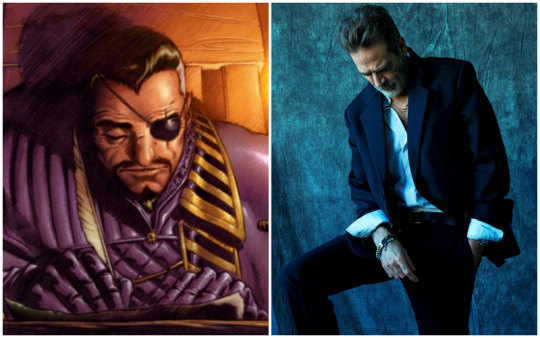
Sir Doctor Stephen Strange - Ioan Gruffudd

Peter Parquagh - Griffin Gluck
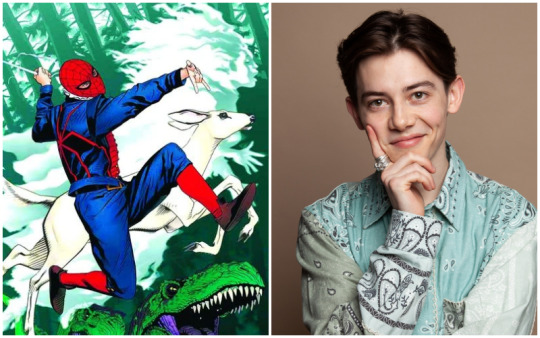
Clea - Malin Akerman

Matthew Murdoch - Michael Welch
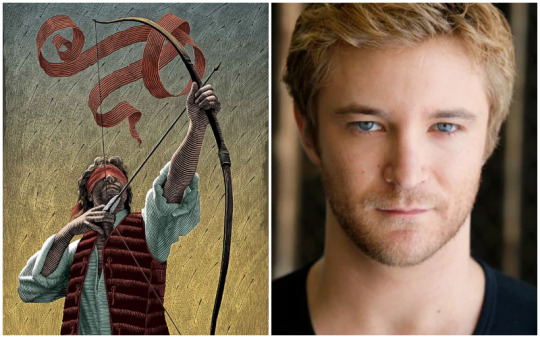
Rojhaz/Steven Rogers - Scott Eastwood
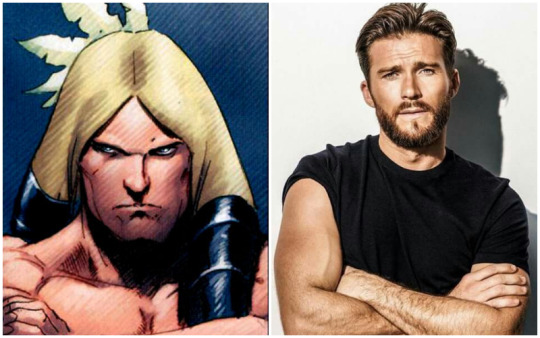
Carlos Javier - Mark Strong
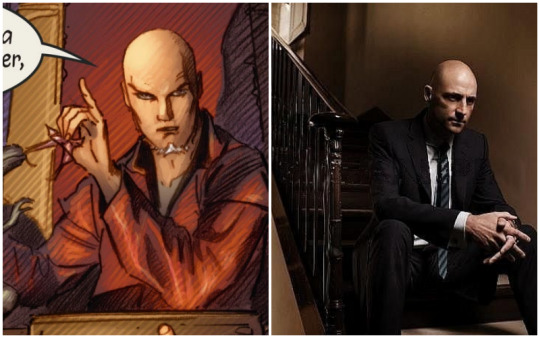
Scotius Sumerisle - Zachary Gordon
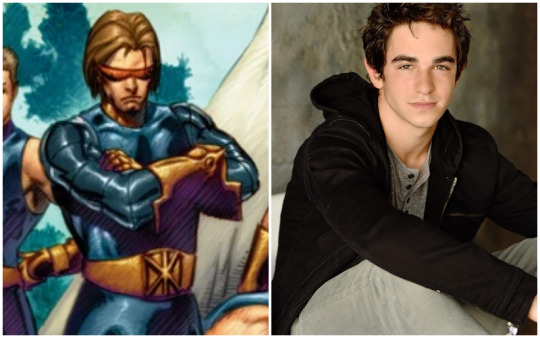
Robert Trefusis - Noah Schnapp
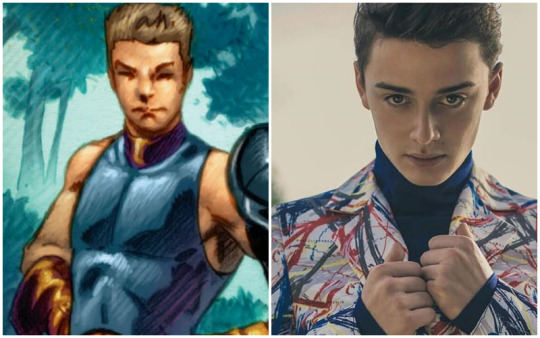
Jean Grey - Annalise Basso

Werner - Charlie Plummer

Natalia Romanova - Elena Satine
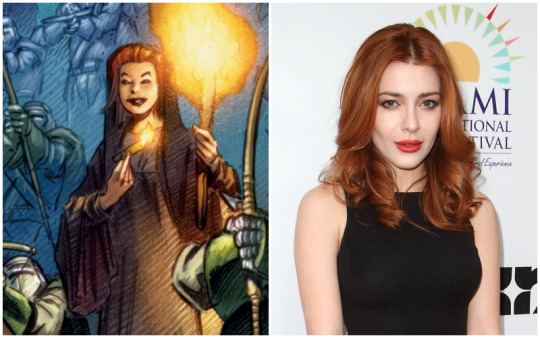
Grand Inquisitor - Jason Isaacs
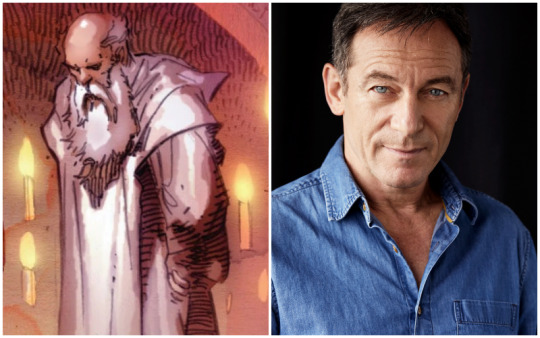
Sister Wanda - Tristin Mays

Brother Petros - Chuku Modu
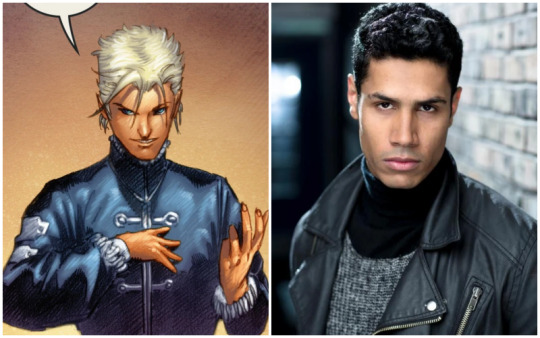
Uatu the Watcher - Clancy Brown

#runilafancasts#marvel#fan cast#jeffrey dean morgan#ioan gruffudd#griffin gluck#malin akerman#michael welch#scott eastwood#mark strong#zachary gordon#noah schnapp#annalise basso#charlie plummer#elena satine#jason isaacs#tristin mays#chuku modu#clancy brown
13 notes
·
View notes
Text

Henri Albers in the title role of Chausson's Le Roi Arthus, which he created at the Monnaie in Bruxelles in 1903.
Henri Albers, born Johan Hendrik Albers (1 February 1866 – 12 September 1926),[1] was a Dutch-born opera singer who later became a French citizen. He sang leading baritone roles in an international career that spanned 37 years and was a prominent singer at the Théâtre de la Monnaie in Brussels and the Opéra-Comique in Paris, which was his base from 1900 until his death. He also sang in 36 performances with the Metropolitan Opera company from 1898 to 1899. He made many recordings for Pathé Records and specialised in the heavier baritone and basso cantante repertoire.
Albers was born in Amsterdam and initially Albers was born in Amsterdam and initially trained and worked as an actor. He then studied singing at the Conservatorium van Amsterdam and was engaged by Johannes George De Groot to sing with his newly established Hollandsche Opera company. He made his operatic debut in 1889 as Méphistophélès in a Hollandsche Opera production of Gounod's Faust and during the next two years continued singing leading roles with the company. In 1891, on the recommendation of De Groot, he met with the French composer Jules Massenet and auditioned for him. Massenet was impressed and encouraged him to study further in Paris and to broaden his horizons beyond Amsterdam. After further singing studies in Paris with Jean-Baptiste Faure, Albers made his first stage appearance outside Holland when he was engaged by the French opera company in Antwerp. In 1892, he sang Jean d'Hautecoeur in the company's first production of Alfred Bruneau's Le rêve and began a lifelong friendship with the composer, appearing in many of his operas.After Antwerp, Albers was engaged as After Antwerp, Albers was engaged as Principal Baritone at the Opéra de Bordeaux and went on to sing at the Royal Opera House in London and the Opéra de Monte-Carlo. He was engaged by the Metropolitan Opera in 1898 and sang with the company both on tour and in New York City. He made his company debut on 8 November 1898 as Mercutio in the Met's touring performance of Roméo et Juliette in Chicago. He remained with the company through 1899, appearing 36 times in eight different operas and tackling his first Wagnerian role, Wolfram in Tannhäuser.On his return to Europe he sang On his return to Europe he sang regularly at the Théâtre de la Monnaie in Brussels from 1901 to 1906 and added several more Wagnerian roles to his repertoire: Telramund in Lohengrin; Hans Sachs in Die Meistersinger von Nürnberg; Wotan in Das Rheingold, Siegfried, and Die Walküre; and Kurwenal in Tristan und Isolde. A highly versatile singer, he also appeared in the title roles of La Monnaie's productions of Hamlet, Rigoletto, Hérodiade, and Le roi Arthus, as well as singing Count di Luna in Il trovatore, Iago in Otello, and Baron Scarpia in Tosca.In 1899, he had also been In 1899, he had also been engaged by the Opéra-Comique in Paris where he sang leading baritone and bass-baritone roles for the next 25 years in 39 different operas. Although it became his "home" opera house, he continued to appear at La Monnaie, the Paris Opéra, and several other European opera houses from time to time. He became a naturalized French citizen in 1920.In late In late August 1926 at Aix-les-Bains, Albers once again sang the role of Jean d'Hautecoeur in Le rêve.A month later, he died in Paris of a sudden illness at the age of 60. At the time of his death, he was on the administrative council of the Union des Artistes dramatiques et lyriques des théâtres français.
#classical music#opera#music history#bel canto#composer#classical composer#aria#classical studies#maestro#chest voice#Henri Albers#Baritone#Opéra-Comique#Metropolitan Opera#Met#Royal Opera House#Covent Garden#Paris Opéra#Le roi Arthus#King Arthur#Ernest Chausson
4 notes
·
View notes
Text
youtube
Carlo Graziani (1710-1787) - Sonata for Cello and Basso Continuo in A Minor
Allegro, Larghetto, Aria
Performers: I Musici di Santa Pelaga · Marco Testori · Ana Raquel Pinheiro · Maurizio Fornero.
4 notes
·
View notes
Text
Acos S.p.A.: ricorso contro la delibera Egato6 e impegno per il territorio. Un nuovo piano per migliorare il servizio idrico e ambientale del Basso Alessandrino
Novi Ligure, 20 gennaio 2025 – Acos S.p.A. ha annunciato il ricorso contro la delibera n. 42 del 30 dicembre 2024 dell’Egato6 Alessandrino, considerata illegittima e contraddittoria rispetto alle normative vigenti
Novi Ligure, 20 gennaio 2025 – Acos S.p.A. ha annunciato il ricorso contro la delibera n. 42 del 30 dicembre 2024 dell’Egato6 Alessandrino, considerata illegittima e contraddittoria rispetto alle normative vigenti. La decisione arriva in un momento cruciale per la gestione dei servizi idrici e ambientali, evidenziando l’importanza di un approccio integrato e solido per il territorio. Un quadro…
#Acos Energia#Acos missione#Acos S.p.A.#Acqua#Alessandria today#aziende pubbliche#Basso Alessandrino#eccellenza industriale#Economia circolare#efficienza idrica#Egato6#Energia#Fondazione ACOS#Gestione Acqua#gestione ambientale#Gestione Ambiente#Gestione rifiuti#Google News#Infrastrutture#Innovazione#Investimenti#italianewsmedia.com#monitoraggio ambientale#normativa regionale#Novi Ligure#Piano Industriale#Pier Carlo Lava#qualità del servizio#Raccolta differenziata#Regione Piemonte
0 notes
Text
Italia: Medieval Era (1)
As requested, a bunch of posts (3) about Italy in the Medioevo and during the Impero Romano (I should start with the latter to give you a proper historical timeline but... yeah, let's make things "funnier").
Italy has been through a various amount of sudden situations and events during its history, but this is especially true when it comes to the Medieval Era. The start of this historical period coincide with the end of the Impero Romano d'Occidente (476 d.C. = after Christ, in Italian it's "dopo Cristo"), while its end is determined by the "Discovery of America" by Colombo in 1492. We generally talk about Alto Medioevo (V-XI century, year 1000) and Basso Medioevo (XI-XV century).
In the Alto Medioevo begins the Era of the Romans and Barbarians Kingdoms in the feudatory's area of Italy: first it was Odoacre with the "Eruli" and then Teodorico with the "Ostrogoti". In the Southern part of Italy, it was Arabs trying to invade our Nation. In the years 535 and 553 d.C., the "Guerra Gotica" between the Ostrogoti and the "Bizantini" of Giustiniano (Emperor of the Impero Romano d'Oriente) took place: at the end, Giustiniano had been able to take control of all the old Impero Romano d'Occidente's areas especially after the Assedio di Napoli and the Assedio di Roma which allowed him to reach Milano and destroy it and conquer Ravenna as well. This war caused lot of poverty, destruction and plague epidemic in Italy, whose cities lost population (also cause the population tried to save themselves and hide on the mountains or the countrysides, which allowed them also to upgrade the ruralization process started in the V century).
The Longobardi though, already few years after the end of the Guerra Gotica, could conquer some of the Italian Region (others stayed under the control of the Bizantini for centuries): they made Pavia their capital city and basically reached the whole Northern Italy (except for some parts of Liguria and Veneto, which fell later on). So by the end of the 7th century, Italy had been divided into two Kingdoms. Side note: Costante had been the first Imperatore Bizantino to actually live in Italy, in Siracusa, but cause of the way he destroyed the Churches and raised taxes, he got assassinated while he was taking a bath. ...Does this remind you of someone else?
In the 8th century the Longobardi could conquer some more areas (also cause the Bizantini kept a political line that wasn't very accepted by the population, so there were lot of revolutions in the Bizantini's areas). This situation worried the Pope who started fearing the loss of his Ducato romano, and therefore he called for the new king of the "Franchi", Pipino il Breve, for help: he could retake control of some of the areas fallen in the hands of Longobardi, and this signed the start of the Stato della Chiesa.*
Later on, the Pope called again the Franchi for help: the new king Carlo Magno could conquer Pavia and became the new king of Longobardi and Franchi together. Under the protection of the Pope, Carlo could win more and more areas and became the Imperatore d'Occidente. At the same time, some areas under the control of the Bizantini, gained more indipendence under their own governors.
A few years after, Carlo Magno, after a battle against the Bizantini, could obtain to become the Imperatore (not of Romani though: this became possible only after the year 1024), with the famous "Trattato di Aquisgrana". With the loss of power by the Longobardi and the start of the Kingdom of the Franchi by Carlo Magno and his sons and nephews, we could say the Regnum Italiae (The Regno d'Italia = the Sacro Romano Impero) was born.
At this point, many wanted to be crowned King of Italy, despite it became a natural right for the Romani/Franchi Orientali (kings of Germany): they all used to be crowned in Pavia or rarely Milano.
Years after, Italy, being part of the Impero Carolingio, became the target of many invasions from Unni, Saraceni and other external populations that only wanted to loot around. With time, the aristocracy tried to find ways to be able to vote for the king as well: this made the actual kings in need to become closer to the aristocracy and gain their political and military favours.
*During the whole Alto Medioevo the Stato della Chiesa with its "potere temporale" (through which the Pope could basically control some areas of the Center of Italy) was the only mean that allowed the Latin culture to survive. Christianity helped the Romans and the Germans to connect and integrate their rules together and give birth to the European culture and also to many Universities. Medieval monks were able to protect and store many different pagan and arabic texts (medicine, math and philosophy) which were of huge help for our culture.
(wikipedia)
#it#italian#italiano#langblr#italian language#italian langblr#language#languages#parole words#italian history#italian culture#italian things#medioevo#medieval era
19 notes
·
View notes
Text
Carlo Graziani (? - 1787) - Sonata for Cello [in scordatura] and Basso continuo in D-Major, II. Allegro con brio. Performed by Gaetano Nasillo, cello, and Sara Bennici, cello (continuo), on period instruments.
#carlo graziani#classicism#rococo#cello#cellist#period performance#period instruments#cello sonata#sonata#chamber music#strings#rarely performed composers#violoncello
34 notes
·
View notes
Text
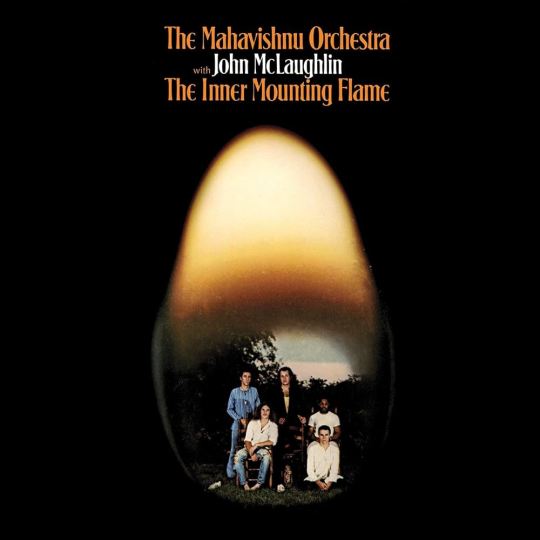
Storia Di Musica #302 - The Mahavishnu Orchestra with John McLaughlin - The Inner Mounting Flame, 1971
Mahavishnu: nella religione induista è uno dei nomi di Vishnu, e vuol dire all'incirca Divina compassione, potere e giustizia. Fu il maestro spirituale Sri Chinmoy, una delle figure più carismatiche e importanti nella diffusione delle filosofie indù in Europa e negli Stati Uniti, a dare questo nome al nuovo progetto di John McLaughlin. Il chitarrista era agli inizi degli anni '70 la nuova stella della chitarra jazz, uno dei personaggi decisivi e più incisivi nella nascita della jazz fusion. Era già famoso per il suo virtuosismo quando nella seconda metà degli anni '60 arriva negli Stati Uniti, dopo aver svezzato un'intera generazione di chitarristi inglesi (primo fra tutti un certo Jimmy Page). E fu quasi per caso che appena prima delle registrazione di In A Silent Way (1969): McLaughlin era negli USA da poche settimane per registrare con il fido batterista del secondo quintetto di Miles Davis, Tony Williams (il disco era Emergency! in power trio Williams, McLaughlin e Larry Young al basso), che con il suo fiuto eccezionale gli chiede di partecipare alle registrazioni. Ed è con il magone in gola per poter suonare con un suo mito che John inizia una collaborazione che lo porterà ad essere punta di diamante del successivo, e inimitabile, Bitches Brew, che fu registrato a poche settimane da In A Silent Way ma che vide la luce solo l'anno successivo. Nel mitico disco, una parte del suo assolo di chitarra in Bitches Brew fu isolato dal lavoro paziente e certosino di Teo Macero alla cabina di regia musicale e divenne un omaggio del maestro al suo chitarrista: John McLaughlin, dove Davis non suona nemmeno. Partecipa anche a On The Corner, ma già durane le prime registrazioni del 1969 fu lo stesso Miles a spingerlo alla carriera solista. Inizia con un gioiello: Extrapolation del 1969 lo vede in quartetto con John Surman (sassofono), Brian Odgers (contrabbasso) e Tony Oxley (batteria) in un disco che si lega ancora al bop ma che contiene già i semi di quell'albero fruttuoso che di lì a pochi anni inizierà a incantare una generazione di musicisti jazz. Nel 1971 fonda la sua band, come mentore Chinmoy, che fu influente consigliere anche di Carlos Santana, che diventerà grande amico e sostenitore del chitarrista inglese. La Mahanishnu Orchestra fu fondata insieme a Jan Hammer alla tastiera, Jerry Goodman al violino, Rick Laird al basso elettrico e Billy Cobham alla batteria, quest'ultimo anch'egli collaboratore di Miles Davis e uno dei più influenti batteristi di tutti i tempi per stile tecnica e innovazioni musicali.
Tutto è pronto per l'esordio. Presso i Cbs Studios tra la 49 East e la 52.ma strada in Midtown, Manhattan, in una sola e leggendaria sessione di prove ad Agosto del 1971, dopo averlo suonato solo un paio di volte in precedenza, viene registrato The Inner Mounting Flame, che esce prodotto da McLaughlin nel Novembre dello stesso anno. Sin da subito si capisce che la sintonia telepatica tra i musicisti è a livelli superiori, e rimarrà proverbiale negli anni a venire, e la scaletta sciorina il meglio della band e delle singole abilità dei musicisti. Meeting Of The Spirits è l'invocazione magica a colpi di assoluti istrionici di McLaughlin alla chitarra e Billy Cobham alla batteria, a cui si aggiungono pian piano quelle degli altri musicisti, in un incedere ipnotico e vorticoso. Con Dawn è come un momento di relativa pausa, un prendere fiato per ripartire con Noonward Race, rappresentazione clamorosa della velocità e della tecnica di Cobham e la chitarra che omaggia il da poco scomparso Jimi Hendrix di McLaughlin, sostenuti dal basso pulsante di Laird, il piano jazzato di Hammer e il violino “scanzonato” di Goodman. A Lotus On Irish Streams vede protagonista il violino di Goodman, grande colonna del brano, che disegna delle scie musicali che davvero fanno pensare al fluire liquido dell'elemento, in uno dei brani più sognanti dell'intero repertorio. Vital Transformation riporta sul groove funk e veloce di Noonward Race ma l'atmosfera cambia per The Dance Of Maya che parte misteriosa, poi diventa blues e finisce nella solita e proverbiale corsa a rincorrersi tra chitarra e batteria, vero marchio di fabbrica della banda. You know, You know, dalla struttura delicata, diventerà fornitura pregiata per molti artisti, ricordo David Sylvian in I Surrender, i Massive Attack in One Love, addirittura il rapper Mos Def, Cecil Otter e altri ancora. Awakening conclude con le tastiere di Hammer un disco dove la velocità e la potenza del motore musicale impressiona ancora oggi per precisione, vitalità e per la padronanza assoluta delle variazioni ritmiche, strutturali e sentimentali dei brani.
Il disco fu un successo, e venderà negli anni un milione di copie, uno dei più grandi successi del jazz. Il successo riporterà in classifica persino i primi esperimenti da solista di McLaughlin. La band si riproporrà con Birds Of Fire del 1973 (dove c'è un omaggio al Maestro in Miles Beyond), altra meraviglia, e si ritrova in studio a Londra, ai Trident, per registrare quello che secondo loro dovrebbe essere l'album definito del connubio jazz e rock. Ma la tensione è alle stelle e la band si scioglie a metà lavoro (qualcosa verrà pubblicato in Between Nothingness & Eternity). La band si scioglie, ma McLaughling continua e stavolta costruisce una nuova grande Orchestra con fiati, trombe e il violino di Jean Luc Ponty, fedele collaboratore di Frank Zappa, ed altri grandi musicisti per ampliare le visioni della musica che ha in mente, con risultati altalenanti. La Mahavishnu Orchestra avrà persino una terza rinascita a metà anni '80, e continuerà ad essere il sogno musicale di un eterno ragazzo inglese che una volta disse: Mia madre dovette sequestrarmi la chitarra per mesi perché stavo tutto il giorno a suonarla e andavo avanti nonostante mi sanguinassero le dita.
12 notes
·
View notes
Text
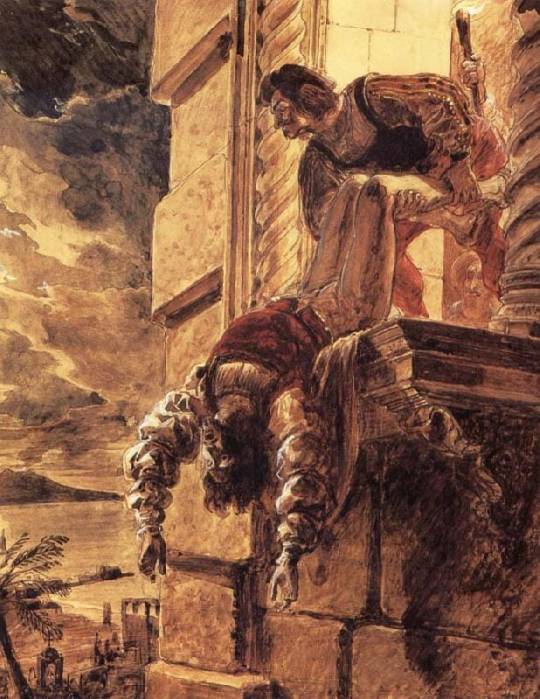
Il 18 settembre 1345, da Visegrad ad Aversa, passando per Muro Lucano per finire a San Pietroburgo, su di un dipinto sbagliato.
Per spiegare il giro mi farò aiutare da Wikipedia.
Andrea d'Angiò, meglio noto come Andrea D'Ungheria, aveva solo sei anni quando "venne fatto sposare" alla lontana parente Giovanna, nipote e unica discendente di Roberto d'Angiò, re di Napoli. Lo scopo perseguito era chiaro a tutti: le nozze avrebbero dovuto riunire i due rami del casato angioino, per mettere fine alla contesa dinastica sulla Corona di Napoli.
Il giovane Andrea crebbe così alla corte napoletana all'ombra di Roberto d'Angiò, pronto a succedergli unitamente alla altrettanto giovane moglie.
Nel 1343, Roberto d'Angiò, però, lasciò solamente alla nipote Giovanna la Corona del «Regno», nonostante le recriminazioni del ramo ungherese.
A quel punto iniziarono varie congiure famigliari, tra i vari discendenti della dinastia angioina, con il coinvolgimento della Santa Sede, di cui il Regno di Napoli era vassallo, per far riconoscere o meno il titolo di «Re» ad Andrea.
Diatribe dinastiche che andarono avanti fino al 1345, quando papa Clemente VI giunse alla conclusione di far incoronare come sovrani entrambi gli sposi: per Andrea il titolo sarebbe stato puramente onorifico, dato che il potere di governo sarebbe rimasto nelle mani della regina Giovanna I.
Poco prima che la decisione fosse resa nota, però, accadde qualcosa: la notte del 18 settembre 1345, al termine di una giornata passata a caccia, il principe venne aggredito mentre si allontanava dalle proprie stanze.
Un folto gruppo di nobili napoletani strinse una corda attorno al suo collo scaraventando il suo corpo giù da una finestra.
Si racconta che le sue urla disperate furono del tutto ignorate dalla regina Giovanna.
Quest'ultima ottenne così il trono in solitaria ma non ottenne la pace, né per sé stessa che per il suo reame.
Luigi I d'Ungheria, fratello di Andrea, portò la guerra fino alle soglie della corte reale, comandando due invasioni del Regno di Napoli.
La responsabilità diretta della sovrana nella morte di Andrea non fu mai provata (e fu esclusa da una sorta di processo tenuto dal papa ad Avignone), ma non bastò.
Trentasette anni dopo, il 12 maggio 1382, dei sicari inviati da Carlo di Durazzo raggiunsero Giovanna nella fortezza di Muro Lucano, dov'era stata nel frattempo rinchiusa, e la uccisero.
Come disse qualcuno, la vendetta è un sentimento che vanta gradi di nobiltà.
Abbiamo, quindi, Visegrad - dove nacque presumibilmente Andrea - e Muro Lucano -dove morì Giovanna-.
Mancano all'appello San Pietroburgo e Aversa.
Rimediamo subito.
La vicenda, famosa nel resto d'Europa ma poco ricordata dalle nostre parti, fu oggetto di un particolare "revival" nell'Ottocento come dimostra quest'opera di Karl Pavlovič Brjullov, pittore romantico, che volle immortalare il momento cui lo sventurato veniva defenestrato.
È un acquerello intenso, nei colori e nelle gestualità ritratte, ma è un acquerello storicamente inesatto.
Sullo sfondo, in basso a sinistra, si nota un vulcano e una spiaggia, come se l'uccisione dell'erede al trono fosse avvenuta a Napoli (o nelle immediate vicinanze).
La congiura, invece, fu portata a termine ad Aversa: Andrea di Ungheria fu scaraventato giù da una finestra del castello angioino che sorgeva là dove oggi vi è la Chiesa della Madonna di Casaluce, su via Roma.
In pieno centro cittadino.
5 notes
·
View notes